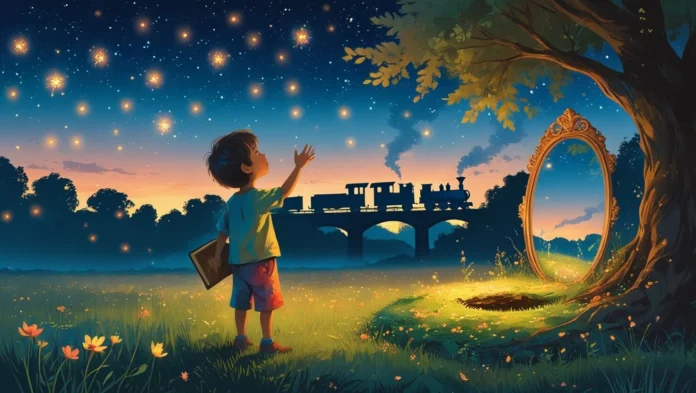The Amazing Sense of Awe
The Lost Sense of Wonder—that magical, inexplicable WoW we experienced as children—had the ability to fill us with pure joy, ignite curiosity, and encourage us to dream boundlessly. It was found in the simplest of moments—watching fireflies flicker like tiny stars in the dark, wholeheartedly believing in magical creatures, or lying beneath the vast night sky, letting our minds drift toward the mysteries of the universe.
We still vividly remember reading Alice in Wonderland for the first time. Though not our favorite fiction book, one of us spent days searching for rabbit holes under trees, hoping to discover a magical adventure. Staring at ornate mirrors, we wondered if they would transform into looking glasses and transport us to another world. The imagination was endless, and the mystery was exhilarating.
In Suchitra’s case, she would clap excitedly every time she saw a train running on a bridge. She even wrote a poem about it. Even today, she stands on platforms, gazing at the Vande Bharat train, wondering what it would be like to travel in it. There was magic in movement, in the way machines worked, in the tiny details of everyday life that held untold stories.
But this is not just about nostalgia—it’s about the sense of wonder that children have today. Do they still experience the same excitement and curiosity that we once did?
Where Has the Sense of Wonder Gone?
When we were children, watching animated movies meant believing in cartoon figures dancing behind the screen. Today, kids watch with a technical mindset, discussing graphics quality or how accurately the movie portrays the original story. The magic seems to have faded. Instead of embracing the unknown, they analyze it, breaking it down into digital pixels and historical accuracy.

We paused to reflect—where did that sense of joy and wonder go?
Children today move from one activity to another, from one video game to the next, with little time to breathe and imagine. The internet has erased the mystery from many things—answers are instant, leaving little space for curiosity to flourish. The sense of adventure in solving mysteries, the thrill of discovery, and the joy of making up our own fantastical explanations have all been replaced with a quick search on a screen.
The Shift from Storytelling to Screens
In the past, we eagerly waited for our favorite aunts and uncles to visit. Some told mythological stories, making us visualize grand tales of Hindu Gods and Goddesses. Their storytelling kept us spellbound, eager for their next visit. Others recounted real-life experiences that sparked a desire to explore, to dream, to create.

Today, children often see relatives as gift machines. Busy parents compensate for their absence with expensive toys and electronic gadgets. The tradition of storytelling has been replaced with screens. Even gifting books has become a challenge, as many adults struggle to choose an age-appropriate read without external help. With entertainment so readily available, children no longer wait for special moments to hear new stories—they simply turn on a device and consume content passively.
The power of oral storytelling wasn’t just about the stories themselves—it was about the connection, the shared experience, and the ability to transport listeners to another world using nothing but words. It fueled the imagination and encouraged deep thinking. When did we stop valuing this?
How to Reignite a Child’s Sense of Wonder
- Encourage Imaginative Play – Reduce screen time and provide open-ended toys like building blocks, art supplies, and costumes for role-play. Let children create their own stories instead of consuming pre-made ones.
- Introduce Storytelling Traditions – Share stories from mythology, folklore, or even personal experiences that make learning exciting. Help them see the magic in words again.
- Explore Nature Together – Spend time outdoors, looking at the sky, examining insects, or wondering about the stars. Encourage them to ask “why?” and let them come up with their own answers before searching for one.
- Ask Open-Ended Questions – Instead of providing instant answers, let children think and explore possible solutions on their own. “What do you think would happen if…” is a great way to spark their creativity.
- Be a Curious Parent – Demonstrate curiosity in everyday things. Show excitement about discoveries, whether it’s a new place, book, or even a historical fact. If they see you being amazed by the world, they will be more likely to feel the same way.
- Create Mystery and Anticipation – Not everything needs to be explained immediately. Sometimes, letting children wait for an answer or make their own deductions can be more exciting than simply handing them the information.
- Encourage Slow Living – Give children time to sit, observe, and daydream without feeling the need to be constantly entertained. Boredom is often the birthplace of creativity.
Conclusion: Keeping the Magic Alive
What did you wonder at as a child? If you are a parent, does your child still experience that magical sense of awe? More importantly—do you?
It’s never too late to reclaim curiosity and inspire the next generation to embrace the magic of wonder again. Whether it’s staring at the stars, making up stories, or simply slowing down to truly see the world, let’s bring back the excitement of discovering the unknown—one moment at a time.


